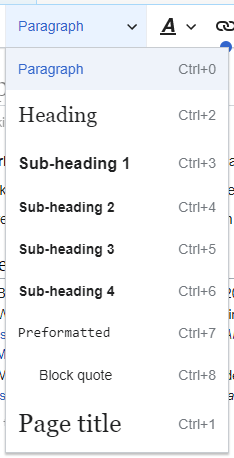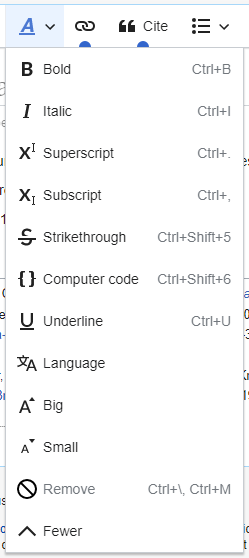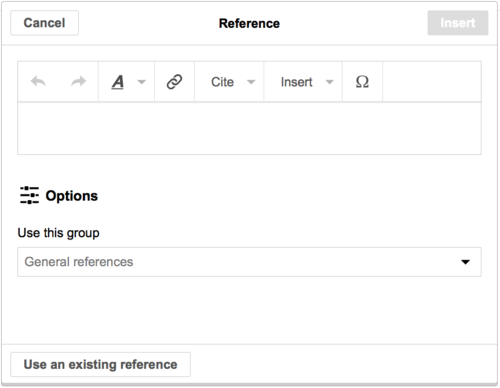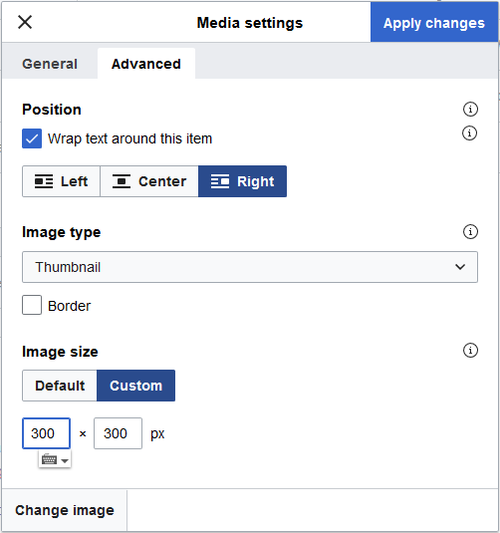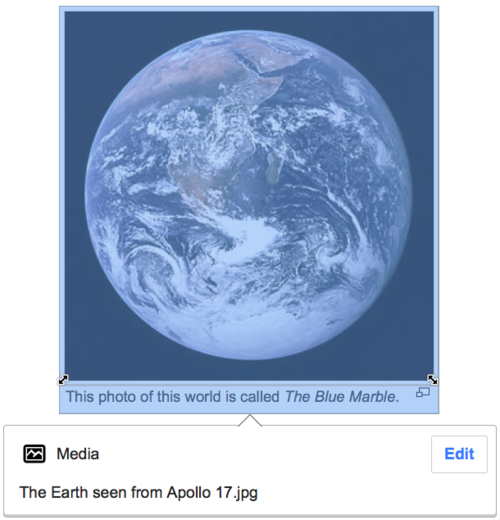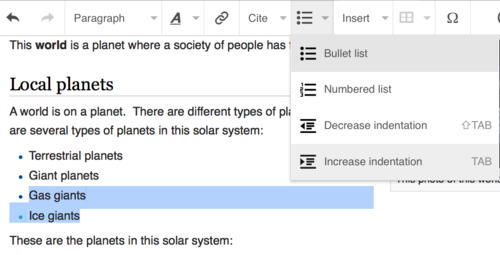|
|
 |
- VisualEditor gives you the ability to edit without needing to learn wikitext markup, as is required by the default Wikitext editor. Unlike that editor, VisualEditor will display the text being edited almost as if it were already published. This guide gives illustrated, step-by-step instructions on the editor's features, although it may occasionally lag behind the release of new ones.
- Be aware that VisualEditor is still in development and thus has known limitations and bugs. For example, particularly for larger pages, VisualEditor can be slower than wikitext, and it is not available on talk/forum/discussion pages, where Structured Discussions tool is in place. While VisualEditor remains in development, you should review your changes to ensure that the edits are those you intended.
|
Availability
VisualEditor is available on the following types of pages (namespaces): Help, Project, Fellow, 2020, User, File, Category, GeoJson, (Main)
First step: enabling VE
If you are registered on Wikipedia, you can opt to make VisualEditor available for editing, by changing your preferences. You'll need a VisualEditor-supported browser; most are. More information can be found here.
If you are not registered, you can still use VisualEditor by adding ?veaction=edit to the end of a Wikipedia page URL. (Registered editors who have not enabled VisualEditor in their preferences - that is, the box for "Temporarily disable the visual editor while it is in beta" option is checked - can do the same.)
Opening VisualEditor
|
|
- To edit a page using VisualEditor, click on the "Edit" tab at the top of the page.
- It can take a few seconds for the page to open for editing, and longer if the page is very long.
- Clicking on the "Edit source" tab will open the classic wikitext source editor.
|
|
|
|
- You can also open VisualEditor by clicking on the "edit" link on each section. Protected pages do not have this link.
|
Getting started: the VisualEditor toolbar
| The VisualEditor toolbar appears at the top of the screen when you begin editing. It includes the following icons:
|
|
|
|
Undo and Redo the changes you have made.
|
|
|
|
Headings pull-down menu: allows you to change how the paragraph is formatted.
- To change the style of a paragraph, put your cursor in the paragraph and select an item in this menu (you don't have to highlight any text).
- Section titles are formatted "Heading", and subsections are "Heading 2", "Heading 3", and so on.
- The normal format for text is "Paragraph".
|
|
|
|
Formatting: Clicking the "A" opens a menu.
- The "Bold" item (B) bolds the selected text.
- The "Italic" item (I) italicizes the selected text.
- The "Superscript" item (x2) causes the selected text to appear smaller than surrounding text and to be slightly higher than the surrounding text.
- The "Subscript" item (x2) causes the selected text to appear smaller than surrounding text and slightly lower than the surrounding text.
- The "Strikethrough" item (
S) adds a solid bar through the selected text.
- The "Computer code" item (a set of curly brackets:
{}) changes the font of the selected text to a monospaced font, which sets it apart from surrounding (proportionally spaced) text.
- The "Underline" item (U) adds a solid line beneath the selected text.
- The "Language" item (Aあ) allows you to label the language (for example, Japanese) and direction (for example, right-to-left) of the selected text.
- The final item (
 ), called "Remove", removes all character formatting from the selected text, including links. ), called "Remove", removes all character formatting from the selected text, including links.
If you have not selected any text, then when you click the "A" to open the menu, and then select an item, that formatting will apply to the text that you start typing, from wherever your cursor is located.
|
|
|
|
Linking tool: The chain icon is the linking tool. Clicking on it (usually after selecting some text) opens the link dialog.
|
|
|
|
Cite menu: The "Cite" menu is used to add inline citations (also called "footnotes" or "references"). All projects have access to "Basic" reference formatting and the ability to "Re-use" citations, using this menu. This menu also gives you quick access to local citation templates, if these are enabled on your wiki.
|
|
|
|
Cite button: If the citoid service is enabled on your wiki, then you will see a "Cite" button instead of a Cite menu.
The citoid service tries to fill out citation templates automatically.
|
|
|
|
Lists and indentation: The first two items allow you to format text as either a "Bullet list" or a "Numbered list". The last two items allow you to decrease or increase the indentation level of list items.
|
|
|
|
Insert: The "Insert" menu may be different on some projects. Below is a list of all options that may appear.
- The "Media" icon (a picture of mountains) opens the media dialog.
- The "Template" icon (a puzzle piece) allows you to edit templates.
- The "Comment" item (a speech balloon with a "!") allows you to insert comments that are not visible to readers; these comments can be seen only when in edit mode and are then indicated by an exclamation mark icon.
- The table item allows you to insert a table.
- The "⧼visualeditor-mwgalleryinspector-title⧽" icon (a set of photos) allows you to insert a gallery to the page.
- The "⧼math-visualeditor-mwmathinspector-title⧽" icon (Σ) opens the formula inserter dialog.
- The "⧼wikihiero-visualeditor-mwhieroinspector-title⧽" icon (an ankh symbol - ☥) allows you to enter the hieroglyphics inserter. (
See below. Not mentioned again.)
- The "⧼visualeditor-dialogbutton-referenceslist-tooltip⧽" icon (three books) opens a dialog in which you can specify where will references be displayed to the reader. Usually this only needs to be done once on every page.
|
|
| Special character insertion: The "Special character" (Ω) icon on the "Insert" menu, when clicked, displays a dialog showing many special characters. By clicking on a specific character, you place it into the text. These special characters include some standard symbols, accents, and mathematical symbols.
|
|
|
|
The Page options menu is to the left of the Publish changes button. On this menu there are options to adjust page settings, such as whether the page is a redirect, or how it is indexed; to add, edit, or delete categories. You can also switch (one-way only) from VisualEditor to the classic wikitext source editor without losing the editing work you've done.
|
Saving changes
|
|
- When you're done editing, click the blue Publish changes button in the toolbar.
- If you have not made any changes, the button will be disabled (grayed out). To cancel all your editing changes, just close your browser window.
|
|
|
|
- Pressing the blue "Publish changes" button opens a dialog. You can then enter a brief summary of your actions, mark your edit as minor, and add the page to your Watchlist.
- You can also review your changes using the "Review your changes" button to be sure they will work as intended before saving your changes.
- The "Resume editing" button returns you to the page you were editing. You can save and publish all of your changes later.
|
Editing links
|
|
Links can be added through the "Link" icon (links in a chain) in the toolbar. If you select (highlight) text and then press the "Link" button, that text will be used in creating the link. For a link that involves just one word, you can either select that word or just put the cursor within that word.
|
|
|
|
When you use either the button or the shortcut, a dialog will open in which you may type the link. VisualEditor will try to help with internal links by looking for likely matches.
|
|
|
|
Once you have entered or selected the link, you complete the linking process by pressing the "Done" button. Your link will immediately appear on the VisualEditor page but, as with other changes to the page, it will not be saved until you 'Publish' the entire page.
|
|
|
|
To link to a web page on another website, the process is the similar: Choose the "External link" tab, and enter a URL in the box.
|
|
|
|
External links without labels look like this: [1]. You can add these by placing your cursor away from any word (e.g., after a space). Open the link tool by clicking on the button or pressing the shortcut keys. Type the URL in the box, and click the "Done" button to insert the link.
|
|
|
|
To change or remove an existing link, click within the text for that link, then press the "Link" icon that appears near it. The dialog will appear, for editing. In the link editing dialog, you can then change where the link goes. You can also remove the link altogether by pressing the "Remove" button in the lower left corner of the dialog.
|
Editing references
Adding a new reference
|
|
|
|
To add a citation using the "Cite" menu, place your cursor where you want to add it in the text. Then select the appropriate citation type in the menu.
|
Using the "Basic" citation
|
|
|
|
Shown here is what you will see if you select the basic references item. In the Reference editor, you can add your citation, including formatting.
You can make the reference belong to a given group, although normally this is left blank. (This option is used to display groups of references with the "References list" tool.)
|
Editing images and other media files
|
|
- To add a new image (or another type of media file) to the page, click the "Media" icon (a picture of mountains) in the "Insert" menu.
- The image will be added wherever your cursor is.
|
|
|
|
- Clicking the "Media" icon opens a dialog that automatically searches Wikimedia Commons and your local wiki for media files related to the title of the page you're editing.
- You can change the search by changing the text in the dialog's search box.
- To choose a file, click on its thumbnail image.
- This places the image onto the page you are editing.
|
|
|
|
- After the image you selected is inserted into the page, another dialog will open.
- This dialog allows you to add and edit the caption of the image. The caption can contain formatting and links.
|
|
|
|
|
You can also set various parameters for the image in the "Advanced settings" window. These include the alignment, the type, and size of the image.
|
|
|
|
When you're done, click "Apply changes" to close the dialog and return to editing the page.
|
|
|
|
- For an existing image, you can add or edit a caption or other settings by clicking on the image, then clicking on the "Media" icon that appears below the picture.
- You can resize an existing image by clicking on it, then moving the resize icon (the two-headed arrow on one or both bottom corners).
- You can also drag and drop an image to a place higher or lower on the page.
|
Editing lists
|
|
- You can use VisualEditor to create lists, or to change the format of an existing list. There are two types of lists: unordered (bullet) and ordered (numbered).
- To start a new list, just click on one of the two menu items shown here. Or, if you already have typed the list (on separate lines), select (highlight) the list you have typed, then click on one of the menu items.
|
|
|
|
Shown here are examples of the two types of lists: unordered (bullet) and ordered (numbered).
|
|
|
|
If you want to change the indentation level of part of an existing list, select the part of the list that you want to change.
|
|
|
|
Then use the menu, or press the Tab key. (The Tab key increases indentation; use the shift key plus the Tab key to decrease indentation)
|
|
|
|
Here is the result of increased indentation.
|
|
|
|
You can even mix ordered (numbered) and unordered (bullet) lists, if the list items have different indentations.
|
|
|



